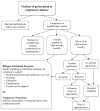Addressing refugee health through evidence-based policies: a case study
- PMID: 28554498
- PMCID: PMC5682239
- DOI: 10.1016/j.annepidem.2017.05.010
Addressing refugee health through evidence-based policies: a case study
Abstract
The cumulative total of persons forced to leave their country for fear of persecution or organized violence reached an unprecedented 24.5 million by the end of 2015. Providing equitable access to appropriate health services for these highly diverse newcomers poses challenges for receiving countries. In this case study, we illustrate the importance of translating epidemiology into policy to address the health needs of refugees by highlighting examples of what works as well as identifying important policy-relevant gaps in knowledge. First, we formed an international working group of epidemiologists and health services researchers to identify available literature on the intersection of epidemiology, policy, and refugee health. Second, we created a synopsis of findings to inform a recommendation for integration of policy and epidemiology to support refugee health in the United States and other high-income receiving countries. Third, we identified eight key areas to guide the involvement of epidemiologists in addressing refugee health concerns. The complexity and uniqueness of refugee health issues, and the need to develop sustainable management information systems, require epidemiologists to expand their repertoire of skills to identify health patterns among arriving refugees, monitor access to appropriately designed health services, address inequities, and communicate with policy makers and multidisciplinary teams.
Keywords: Asylum seekers; Emigrants and immigrants; Epidemiology; Health care disparities; Health policy; Health services; Health status disparities; Minority health; Public policy; Refugees.
Copyright © 2017 Elsevier Inc. All rights reserved.
Figures
References
-
- United Nations High Commissioner for Refugees. [accessed 21.03.17];Global trends: forced displacement 2015. 2015 http://www.unhcr.org/statistics/unhcrstats/576408cd7/unhcr-global-trends....
-
- World Health Organization. [[accessed 21.03.17]];Hungary: assessing health-system capacity to manage sudden, large influxes of migrants. 2016 http://www.euro.who.int/__data/assets/pdf_file/0016/317131/Hungary-repor....
-
- Kärki T, Napoli C, Riccardo F, Fabiani M, Dente MG, Carballo M, et al. Screening for infectious diseases among newly arrived migrants in EU/EEA countries: varying practices but consensus on the utility of screening. Int J Environ Res Public Health. 2014;11(10):11004–14. doi: 10.3390/ijerph111011004. - DOI - PMC - PubMed
Publication types
MeSH terms
Grants and funding
LinkOut - more resources
Full Text Sources
Other Literature Sources


